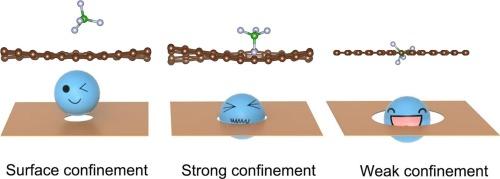用第一性原理计算阐明活性炭超级电容器孔隙缺陷的约束效应
IF 6.9
2区 材料科学
Q2 CHEMISTRY, PHYSICAL
引用次数: 0
摘要
活性炭基超级电容器的性能受到其纳米孔结构的深刻影响,但其在有限空间内的电荷存储机制尚不完全清楚。在本研究中,我们构建了完全自钝化的石墨烯孔缺陷模型来模拟koh活化活性炭的孔结构。利用第一性原理计算,我们阐明了有机电解质组分在孔内的约束行为,并从热力学角度确定了三种不同的约束状态:表面吸附、孔内强约束和孔内弱约束。关键是,我们发现强约束诱导特定的吸附行为,导致分子扭曲甚至电解质分解(例如,乙腈中的键改变,BF4−分解)。这些现象可能通过诱导赝电容效应潜在地增强电容,但也有引发副反应的风险,导致孔隙堵塞和加速器件失效。本工作阐明了约束效应在原子水平上对电荷存储和器件降解的双重作用,为高性能碳电极的设计提供了理论指导。本文章由计算机程序翻译,如有差异,请以英文原文为准。

Elucidate confinement effect of pore defect in activated carbon supercapacitors by first-principles calculation
The performance of activated carbon-based supercapacitors is profoundly influenced by their nanoporous structure, yet the charge storage mechanisms within confined spaces remain incompletely understood. In this study, we construct fully self-passivated graphene pore defect models to simulate the orifice structure of KOH-activated activated carbon. Using first-principles calculations, we elucidate the confinement behavior of organic electrolyte components within the pores and identify three distinct confinement states from a thermodynamic perspective: surface adsorption, in-pore strong confinement, and in-pore weak confinement. Crucially, we discover that strong confinement induces specific adsorption behaviors, leading to molecular distortion and even decomposition of electrolytes (e.g., bond alteration in acetonitrile, decomposition of BF4−). These phenomena may potentially enhance capacitance through induced pseudocapacitive effects, but also risk triggering side reactions that cause pore blockage and accelerated device failure. This work clarifies the dual role of the confinement effect at the atomic level, for both charge storage and device degradation, providing theoretical guidance for the design of high-performance carbon electrodes.
求助全文
通过发布文献求助,成功后即可免费获取论文全文。
去求助
来源期刊

Applied Surface Science
工程技术-材料科学:膜
CiteScore
12.50
自引率
7.50%
发文量
3393
审稿时长
67 days
期刊介绍:
Applied Surface Science covers topics contributing to a better understanding of surfaces, interfaces, nanostructures and their applications. The journal is concerned with scientific research on the atomic and molecular level of material properties determined with specific surface analytical techniques and/or computational methods, as well as the processing of such structures.
 求助内容:
求助内容: 应助结果提醒方式:
应助结果提醒方式:


